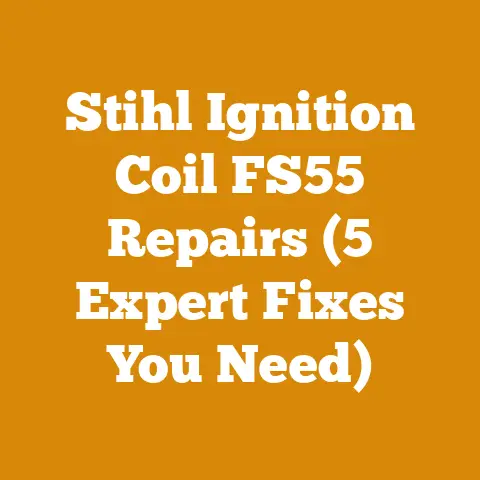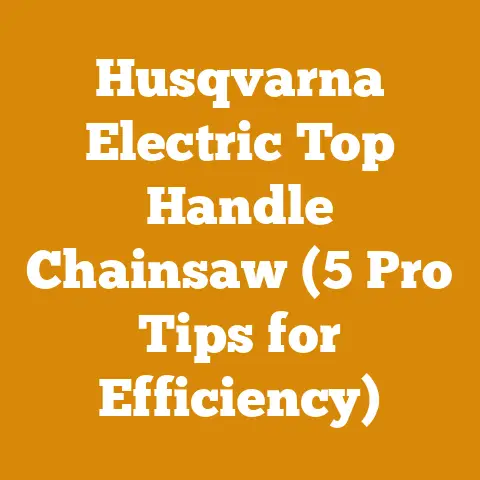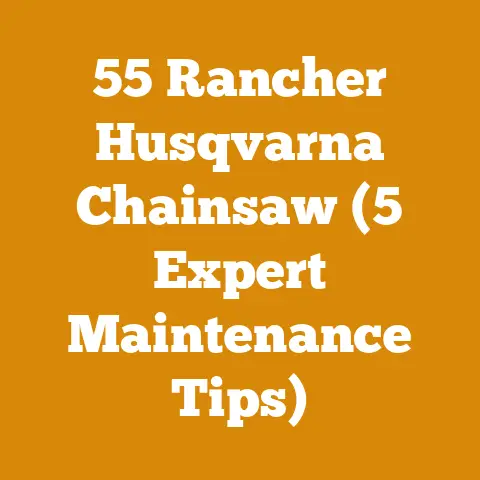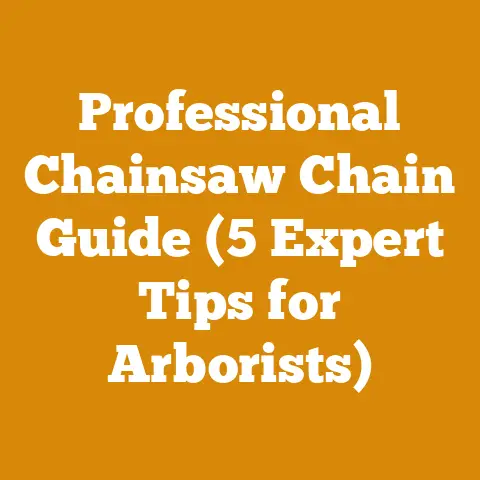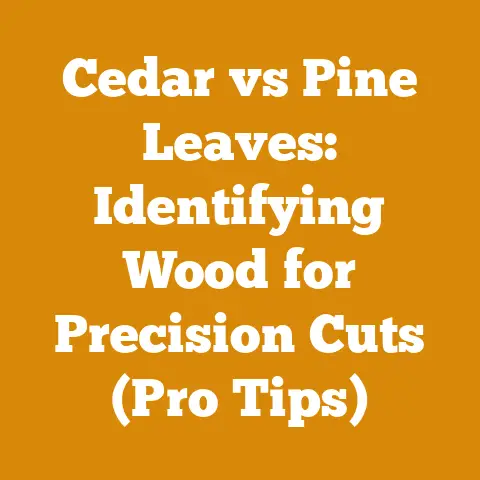Plastic Blade Weed Eater Safety Tips (7 Pro Arborist Insights)
I’ve been working with wood and power tools for over 20 years, and I’ve learned that even seemingly simple tools like plastic blade weed eaters demand respect and a thorough understanding of safety. Investing in safety upfront saves you money in the long run by preventing injuries, equipment damage, and project delays. Let’s dive into how to use these tools safely and effectively, drawing on my experience and insights from fellow arborists.
Plastic Blade Weed Eater Safety Tips: 7 Pro Arborist Insights
Plastic blade weed eaters, also known as string trimmers or weed whackers, are indispensable tools for maintaining lawns, gardens, and landscapes. While they might seem less intimidating than their metal-bladed counterparts, they still pose significant risks if not handled properly. This guide will walk you through essential safety practices, drawing on my experience and the collective wisdom of fellow arborists, to ensure you can use these tools safely and efficiently.
1. Understanding Your Equipment
Before you even think about starting your weed eater, it’s crucial to know your machine inside and out. I can’t stress this enough – familiarity breeds confidence, but overconfidence breeds accidents.
- Read the Manual: Yes, I know, manuals are boring. But trust me, your weed eater’s manual contains vital information about its specific features, safety guidelines, and maintenance procedures. I’ve seen too many people skip this step and end up damaging their equipment or, worse, injuring themselves.
- Identify Key Components: Take the time to identify all the key components of your weed eater, including the power switch, throttle, safety guard, cutting head, and string or blade feed mechanism. Understanding how each part functions is essential for safe operation.
- Inspect Before Each Use: Before each use, give your weed eater a thorough inspection. Look for any signs of damage, such as cracks, loose screws, or frayed cords. Check the condition of the plastic blades, ensuring they are securely attached and not excessively worn or damaged. Replace any worn or damaged parts immediately.
- Blade Type Matters: Not all plastic blades are created equal. Some are designed for light-duty trimming, while others are more robust and suitable for heavier vegetation. Using the wrong type of blade can lead to premature wear, breakage, and potential hazards. Refer to your owner’s manual for recommended blade types.
- Case Study: I once saw a colleague use a blade that was too brittle for the task at hand. It shattered mid-swing, sending pieces of plastic flying. Luckily, no one was hurt, but it was a stark reminder of the importance of using the right equipment for the job.
Takeaway: Knowing your equipment is the first line of defense against accidents. Read the manual, inspect before each use, and use the correct blade type.
2. Personal Protective Equipment (PPE) is Non-Negotiable
PPE isn’t just a suggestion; it’s a necessity. I’ve had close calls over the years, and I can tell you firsthand that proper PPE can make the difference between a minor inconvenience and a serious injury.
- Eye Protection: This is arguably the most critical piece of PPE when using a weed eater. Plastic blades can fling debris at high speeds, posing a significant risk to your eyes. Always wear safety glasses or a face shield to protect your eyes from flying objects. I personally prefer a full face shield because it offers broader protection.
- Hearing Protection: Weed eaters can be noisy, especially gas-powered models. Prolonged exposure to loud noise can lead to hearing damage. Wear earplugs or earmuffs to protect your hearing. I use noise-canceling earmuffs, which not only protect my hearing but also allow me to listen to music or podcasts while I work.
- Gloves: Gloves protect your hands from blisters, cuts, and abrasions. Choose gloves that provide a good grip and allow you to maintain control of the weed eater. I prefer leather gloves with reinforced palms for added durability and protection.
- Long Pants and Sturdy Shoes: Wear long pants and sturdy shoes or boots to protect your legs and feet from flying debris and accidental contact with the blade. Avoid wearing shorts or sandals when operating a weed eater. Steel-toed boots offer the best protection, especially in rough terrain.
- Dust Mask: When working in dusty or dry conditions, wear a dust mask to prevent inhalation of dust and debris. Prolonged exposure to dust can irritate your respiratory system and lead to health problems. I always keep a supply of N95 masks on hand for these situations.
- Personal Story: I once neglected to wear eye protection while weed eating and ended up with a small piece of plastic lodged in my eye. It was a painful experience and a valuable lesson learned. Now, I never operate a weed eater without proper eye protection.
Takeaway: PPE is your shield against potential hazards. Always wear eye protection, hearing protection, gloves, long pants, sturdy shoes, and a dust mask when necessary.
3. Clearing the Work Area
A safe work area is a clear work area. Before you start trimming, take the time to clear the area of any potential hazards.
- Remove Obstacles: Remove any rocks, branches, toys, or other objects that could be struck by the blade and become projectiles. I once accidentally launched a small rock through a window while weed eating. It was an embarrassing and costly mistake.
- Identify Hazards: Identify any potential hazards in the work area, such as underground utilities, irrigation lines, or buried cables. Contact your local utility company before digging or trimming near these areas.
- Keep People and Pets Away: Ensure that people and pets are kept at a safe distance from the work area. A good rule of thumb is to maintain a radius of at least 50 feet around the weed eater. I always make sure my kids and pets are safely inside before I start trimming.
- Watch for Wildlife: Be aware of any wildlife in the area, such as birds, squirrels, or rabbits. Avoid trimming near nests or burrows. I once accidentally disturbed a nest of baby birds while weed eating. It was a heartbreaking experience, and I now take extra care to avoid harming wildlife.
- Communicate with Others: If you’re working in a public area, communicate with others to let them know you’re operating a weed eater. Use warning signs or cones to alert people to the potential hazards.
- Real-World Example: I was working on a landscaping project in a residential area when a child ran into the work area while I was weed eating. Luckily, I saw him in time and was able to stop the machine before an accident occurred. This incident reinforced the importance of maintaining a clear and safe work area.
Takeaway: A clear work area minimizes the risk of accidents and injuries. Remove obstacles, identify hazards, and keep people and pets at a safe distance.
4. Starting and Stopping Procedures
Starting and stopping a weed eater might seem straightforward, but there are specific procedures that should be followed to ensure safety.
- Read the Starting Instructions: Consult your owner’s manual for specific starting instructions for your weed eater model. Different models may have different starting procedures.
- Secure Footing: Ensure you have a firm and stable footing before starting the weed eater. Avoid starting the machine on uneven or slippery surfaces.
- Keep Clear of the Cutting Head: Keep your hands and feet clear of the cutting head when starting the weed eater. The blade can start spinning unexpectedly, causing injury.
- Use the Proper Starting Technique: Use the proper starting technique as described in the owner’s manual. Avoid pulling the starter cord too hard or too quickly, as this can damage the engine.
- Throttle Control: Once the weed eater is running, gradually increase the throttle to the desired speed. Avoid revving the engine excessively, as this can lead to premature wear and tear.
- Stopping the Weed Eater: To stop the weed eater, release the throttle and turn off the power switch. Allow the blade to come to a complete stop before setting the machine down.
- Emergency Stop: Familiarize yourself with the emergency stop procedure. In case of an emergency, you need to be able to quickly shut off the weed eater.
- My Experience: I once had a weed eater that was difficult to start. I kept pulling the starter cord too hard, and eventually, it snapped. I learned my lesson and now follow the starting instructions carefully.
Takeaway: Follow the proper starting and stopping procedures to prevent accidents and damage to the equipment.
5. Safe Operating Techniques
Operating a weed eater safely requires more than just starting and stopping it correctly. It also involves using proper techniques to minimize the risk of injury.
- Maintain a Firm Grip: Always maintain a firm grip on the weed eater with both hands. This will help you maintain control of the machine and prevent it from slipping or jerking.
- Keep a Wide Stance: Stand with your feet shoulder-width apart to maintain balance and stability. Avoid leaning too far forward or backward.
- Use a Smooth Sweeping Motion: Use a smooth, sweeping motion when trimming. Avoid jerky or erratic movements.
- Avoid Contact with Hard Objects: Avoid contact with hard objects such as rocks, trees, or fences. This can damage the blade and cause the weed eater to kick back.
- Trim at the Correct Height: Trim at the correct height to avoid scalping the lawn or damaging plants. Adjust the cutting head to the desired height.
- Work in Sections: Work in sections to avoid fatigue and maintain control. Take frequent breaks to rest and rehydrate.
- Be Aware of Your Surroundings: Be aware of your surroundings and watch out for potential hazards. Pay attention to where you’re walking and avoid tripping or falling.
- Case Study: I once saw a landscaper who was trimming too close to a fence. The blade hit the fence and shattered, sending pieces of plastic flying. He was lucky to avoid injury, but it was a reminder of the importance of maintaining a safe distance from hard objects.
- Cutting Direction: Always cut away from your body. This minimizes the risk of debris being thrown towards you.
Takeaway: Use safe operating techniques to minimize the risk of injury. Maintain a firm grip, keep a wide stance, use a smooth sweeping motion, and avoid contact with hard objects.
6. Maintenance and Storage
Proper maintenance and storage are essential for keeping your weed eater in good working condition and ensuring its longevity.
- Clean After Each Use: Clean the weed eater after each use to remove dirt, debris, and grass clippings. Use a brush or cloth to wipe down the machine.
- Inspect for Damage: Inspect the weed eater for any signs of damage, such as cracks, loose screws, or frayed cords. Repair or replace any damaged parts immediately.
- Sharpen or Replace Blades: Sharpen or replace the plastic blades as needed. Dull blades can be less effective and more likely to break.
- Check the Air Filter: Check the air filter regularly and clean or replace it as needed. A dirty air filter can reduce engine performance and cause damage.
- Lubricate Moving Parts: Lubricate moving parts, such as the cutting head and throttle cable, with a light oil or grease. This will help prevent wear and tear.
- Store in a Safe Place: Store the weed eater in a safe and dry place, away from children and pets. Hang it on a wall or place it on a shelf to prevent it from being knocked over.
- Fuel Storage: If you have a gas-powered weed eater, store the fuel in a properly labeled container in a well-ventilated area. Keep fuel away from heat sources and open flames.
- Battery Care: For battery-powered weed eaters, follow the manufacturer’s instructions for charging and storing the battery. Avoid overcharging the battery or exposing it to extreme temperatures.
- My Routine: I have a regular maintenance schedule for my weed eater. I clean it after each use, inspect it weekly, and perform a more thorough maintenance check monthly. This helps me keep it in good working condition and prevents problems from developing.
Takeaway: Proper maintenance and storage are essential for keeping your weed eater in good working condition and ensuring its longevity.
7. Recognizing and Avoiding Common Mistakes
Even experienced users can make mistakes when operating a weed eater. Being aware of common mistakes and how to avoid them can help prevent accidents and injuries.
- Neglecting PPE: As I’ve emphasized, neglecting PPE is a major mistake. Always wear the appropriate PPE, even for short or simple tasks.
- Using the Wrong Blade: Using the wrong type of blade can lead to premature wear, breakage, and potential hazards. Refer to your owner’s manual for recommended blade types.
- Trimming Too Close to Objects: Trimming too close to objects such as fences, walls, or trees can damage the blade and cause the weed eater to kick back. Maintain a safe distance.
- Overextending Your Reach: Overextending your reach can cause you to lose your balance and control of the weed eater. Avoid reaching too far and move closer to the area you’re trimming.
- Working When Fatigued: Working when fatigued can impair your judgment and coordination, increasing the risk of accidents. Take frequent breaks to rest and rehydrate.
- Ignoring Warning Signs: Ignoring warning signs, such as unusual noises or vibrations, can lead to equipment failure and potential hazards. Investigate any warning signs immediately.
- Modifying the Equipment: Modifying the equipment in any way can compromise its safety and void the warranty. Only use genuine replacement parts.
- Personal Insight: I once tried to modify my weed eater to make it more powerful. It was a terrible idea. The modification made the machine unstable and dangerous to use. I learned my lesson and now only use genuine replacement parts.
- Rushing the Job: Rushing the job often leads to mistakes and accidents. Take your time and focus on safety.
Takeaway: Be aware of common mistakes and how to avoid them. Neglecting PPE, using the wrong blade, trimming too close to objects, overextending your reach, and working when fatigued are all common mistakes that can lead to accidents and injuries.
By following these seven pro arborist insights, you can significantly reduce the risk of accidents and injuries while using a plastic blade weed eater. Remember, safety is not just a set of rules; it’s a mindset. Always prioritize safety and take the time to do things right. Your well-being, and the well-being of those around you, depends on it. Now, get out there and trim with confidence, knowing you’re doing it safely and effectively.

